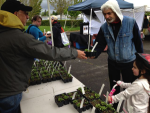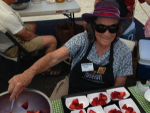Fat of The Land - Like Pepper for Pepper
Guest User

Most people who went to grade school in the United States know that in 1492 Columbus sailed the ocean blue. As I remember it, he was hired by the king of Spain to sail farther west than anyone before him had (anyone, that is, on 15th Century Europe’s radar) and to settle, once and for all, the age-old argument over whether the earth was round or flat. In third grade, that logic was good enough for me. And, becoming something of a Columbus Day protestor in my teenage years (after my brother read a book called, Lies My Teacher Told Me, that detailed all the atrocities Columbus unleashed upon the New World), I put the whole story on the back shelf.
Years later, I picked up a library book on the spice trade (Spice: The History of a Temptation, by Jack Turner), where I promptly learned that Columbus headed west not to solve some existential puzzle, but for the very practical reason of securing a more direct trade route to import black pepper from India. He did it for two reasons that sound jarringly familiar to our contemporary minds: money and ego.
Pepper, that uber-ordinary seasoning we take completely for granted, was as precious as gold in Columbus’ day—a sign of wealth, a highly valued commodity in very short supply, a craze. Men lost their lives fetching pepper, and everyone thought it was worth it. With the fall of Constantinople in 1453, the Silk Road became too dangerous for commerce, so the Portuguese (who monopolized the spice trade at the time) took to the sea, rounding the horn of Africa in order to reach the pepper-producing coast of southern India. Spain was looking to outdo their northern rival by finding a shortcut.
When Columbus landed in the Bahamas, he thought it was (or close enough to) the East Indies. And when, in keeping with his plan, he looked for black pepper, he came upon chiles. Of those arresting fruits he and his fellow explorers found in such profusion, one crewmember wrote: “In those islands there are also bushes like rose bushes, which make fruit as long as cinnamon, full of small grains as biting as [Asian] pepper; those Caribs and the Indians eat that fruit like we eat apples.”
Our modern palates separate the two peppers by a wide margin—black pepper is floral, pleasantly bitter, stinging the tongue with a quick zing only when eaten in excess; chile peppers are fruity, acidic, sour, often sweet, with a sensation we call heat that ranges from a mild tingle to something akin to the mind-altering hammer of a white-hot brand. Europeans had trouble with chiles (and still do), though hot peppers found a home at the margins—Eastern Europe’s paprika, Southern Europe’s spicy sauces and cured meats.
Where it’s hard to imagine that chile peppers were only introduced a mere 500 years ago is nearly everyplace else: Korea, India, Thailand, Ethiopia, China, and Senegal, to name a few famously spicy Diasporas. These cultures quickly adopted the chile pepper as their own, exploring its wealth of genetic traits and producing a mind-boggling collection of new varieties (one that continues to grow today). At a recent count, there were 79 distinct varieties passing under the umbrella of “Thai pepper,” a barometer that helps to translate the enormity of chile pepper diversity.
Then, of course, there is Mexico—the chile’s homeland and where its role in the cuisine is still, arguably, the most refined. Believed to be one of the first domesticated plants, chiles, along with corn and squash, constituted a mainstay of the Central American diet. From my own quasi-European perspective (averse, I hesitate to admit, to all but modest chili pepper heat), I’ve never thought of chiles as more than a seasoning. Like the black pepper they are named for, chiles unquestionably add dimension to a dish, but not substance, not weight. I did try to make myself more tolerant of them once, devoting an entire summer to cooking progressively spicier dishes until the persistent heartburn and other unpleasant side effects forced me to admit defeat. But even then, they were an addition, an adornment, a very small percentage of a dish’s overall volume; not at all, as that Spanish sailor reported, like apples.
But he (and the sophisticated cuisine he observed) was right. The first time I fully appreciated chiles in their own rite was when I watched friends make red mole from scratch. The pile of dried chiles and their seeds—toasted separately and ground together with water, warming spices, and nuts; thickened by hours of stirring and simmering; and at the very end, finished with dark chocolate—was, to my eyes, overwhelming. While process was beautiful and ritualistic, I wasn’t entirely sure I would be able to eat the results. But the sauce, only mildly spicy, exuded a graceful, effortless richness that compelled me to keep spooning it into my mouth, that fed both my simple, daily hunger and the one that no apple has ever quite quenched: the hunger for enchantment, for transformation, for food that drops an anchor and lingers, warmly, long after the meal is finished.
Sarah West is a gardener, eater and admirer of the agricultural arts. She gladly spends her Sundays as assistant manager of the Hillsdale Farmers’ Market, basking in the richness of its producers’ bounty and its community’s energy. Find archives and more at http://thefatofthelandblog.wordpress.com.


















 Menu Item #2: Giant Tater Tots – Organic russet potatoes are mashed with seasonal vegetables and coated in Tabor Bread panko, fried in palm oil, and served with house-made carrot ketchup.
Menu Item #2: Giant Tater Tots – Organic russet potatoes are mashed with seasonal vegetables and coated in Tabor Bread panko, fried in palm oil, and served with house-made carrot ketchup. Menu Item #3: Karokke – This traditional fritter made of sweet potato or winter squash, organic raisins, and Japanese curry blend is a snack Fumiko fondly recalls purchasing as a child on her way home from school. Coated in Tabor Bread panko and fried in palm oil, Obon serves their karokke drizzled with tangy house-made Tamarind sauce.
Menu Item #3: Karokke – This traditional fritter made of sweet potato or winter squash, organic raisins, and Japanese curry blend is a snack Fumiko fondly recalls purchasing as a child on her way home from school. Coated in Tabor Bread panko and fried in palm oil, Obon serves their karokke drizzled with tangy house-made Tamarind sauce. Menu Item #4: Sprouted Brown Rice Onigiri – For this gluten-free treat, sprouted brown rice is blended with Japanese-style pickled organic vegetables, and filled with Obon’s signature tofu misozuke before being shaped and nestled into an organic nori wrapper. Onigiri are a classic Japanese lunch box staple, and a vehicle for each cook to showcase her own unique style.
Menu Item #4: Sprouted Brown Rice Onigiri – For this gluten-free treat, sprouted brown rice is blended with Japanese-style pickled organic vegetables, and filled with Obon’s signature tofu misozuke before being shaped and nestled into an organic nori wrapper. Onigiri are a classic Japanese lunch box staple, and a vehicle for each cook to showcase her own unique style.
 The dynamic duo behind Kookoolan Farms, Chrissie and Koorosh Zaerpoor, met while working as program managers at Intel (Koorosh still works there). The couple married and began dreaming a world outside of Intel where they could work together on a project that integrated their engineering skills with more personal interests: Chrissie was an avid gardener and cook with a passion for home mead making, Koorosh still harbored dreams of becoming a farmer he’d hatched as a child in Iran helping out with his parents’ poultry flock.
The dynamic duo behind Kookoolan Farms, Chrissie and Koorosh Zaerpoor, met while working as program managers at Intel (Koorosh still works there). The couple married and began dreaming a world outside of Intel where they could work together on a project that integrated their engineering skills with more personal interests: Chrissie was an avid gardener and cook with a passion for home mead making, Koorosh still harbored dreams of becoming a farmer he’d hatched as a child in Iran helping out with his parents’ poultry flock. This may seem like an obvious direction for a poultry farm to grow, but the reality of achieving it was far more difficult than the Zaerpoors initially realized. Though regulations have changed somewhat since Kookoolan’s 2005 startup (especially for farmers with fewer than a thousand birds), the USDA has strict codes that make it prohibitively expensive for small producers to operate their own slaughter facility. Kookoolan persevered and became the first farm of their size in Oregon to accomplish this feat. As their processing ability increased, they realized that the five-acre plot they purchased in 2005 would not be sufficient to produce the flock sizes required to build a sustainable business.
This may seem like an obvious direction for a poultry farm to grow, but the reality of achieving it was far more difficult than the Zaerpoors initially realized. Though regulations have changed somewhat since Kookoolan’s 2005 startup (especially for farmers with fewer than a thousand birds), the USDA has strict codes that make it prohibitively expensive for small producers to operate their own slaughter facility. Kookoolan persevered and became the first farm of their size in Oregon to accomplish this feat. As their processing ability increased, they realized that the five-acre plot they purchased in 2005 would not be sufficient to produce the flock sizes required to build a sustainable business. With careful planning, Kookoolan Farms became a cooperative of ethical meat and poultry farmers, greatly expanding their product line, and distributing the labor to a network of specialists. Chrissie remains the hub of operations, coordinating the farm’s wholesale distribution, farmers market sales, and, of course, quality control. The cooperative model finally freed up some of the Zaerpoor’s time, allowing them to expand their vegetable garden into a summer CSA program and giving Chrissie time to get back into mead.
With careful planning, Kookoolan Farms became a cooperative of ethical meat and poultry farmers, greatly expanding their product line, and distributing the labor to a network of specialists. Chrissie remains the hub of operations, coordinating the farm’s wholesale distribution, farmers market sales, and, of course, quality control. The cooperative model finally freed up some of the Zaerpoor’s time, allowing them to expand their vegetable garden into a summer CSA program and giving Chrissie time to get back into mead. The original Kookoolan Farm site still houses a portion of the farm’s pastured chickens, their poultry processing facility, a serve-yourself farm store, the vegetable rows, a small plot of pinot noir grapes, and the new Mead Superstore.Visitors are welcome on weekends (or during the week, by appointment) to browse their selection of over 150 different meads and taste Kookoolan’s own farm-made Elegance Mead, kombucha, and Vin de Noix. What about those pinot noir grapes? Well, they may just show up in the Kookoolan lineup soon in the form of a pinot-mead blend known as pyment.
The original Kookoolan Farm site still houses a portion of the farm’s pastured chickens, their poultry processing facility, a serve-yourself farm store, the vegetable rows, a small plot of pinot noir grapes, and the new Mead Superstore.Visitors are welcome on weekends (or during the week, by appointment) to browse their selection of over 150 different meads and taste Kookoolan’s own farm-made Elegance Mead, kombucha, and Vin de Noix. What about those pinot noir grapes? Well, they may just show up in the Kookoolan lineup soon in the form of a pinot-mead blend known as pyment. As farmers’ market shoppers, we’ve come to know many of our foods by name. Gone are the days when a tomato was just a tomato; now we want Brandywine, Purple Calabash, Oregon Star. Anonymous berries just won’t do anymore and we wait in line for Chesters, Triple Crowns, or Hoods. We make the effort to remember these names because we remember the flavors that come with them.
As farmers’ market shoppers, we’ve come to know many of our foods by name. Gone are the days when a tomato was just a tomato; now we want Brandywine, Purple Calabash, Oregon Star. Anonymous berries just won’t do anymore and we wait in line for Chesters, Triple Crowns, or Hoods. We make the effort to remember these names because we remember the flavors that come with them. has recently restarted an old tradition of public vegetable variety trials. Unlike the secretive work of seed breeders developing new (often patentable) varieties, a public trial consists of varieties already released (or near release) and its purpose is to compare attributes of similar plants. I recently attended an open field day at NWREC with a group of area growers to have a look at the crops and taste the differences. The one-acre site is planted in a patchwork of varieties and doubles as a learning garden for the center’s educational programs (including the excellent
has recently restarted an old tradition of public vegetable variety trials. Unlike the secretive work of seed breeders developing new (often patentable) varieties, a public trial consists of varieties already released (or near release) and its purpose is to compare attributes of similar plants. I recently attended an open field day at NWREC with a group of area growers to have a look at the crops and taste the differences. The one-acre site is planted in a patchwork of varieties and doubles as a learning garden for the center’s educational programs (including the excellent  This year’s trials focused primarily on the Asian specialty market, with Thai basil, leaf celery, cilantro, yu choi, and gailan. We also got to taste a selection of soon-to-be released beets from breeders at the University of Wisconsin, and still-in-development mild habaneros, a project of OSU breeder Jim Myers.
This year’s trials focused primarily on the Asian specialty market, with Thai basil, leaf celery, cilantro, yu choi, and gailan. We also got to taste a selection of soon-to-be released beets from breeders at the University of Wisconsin, and still-in-development mild habaneros, a project of OSU breeder Jim Myers.


 Sweet, bite-sized, and available in a rainbow of colors, the cherry tomato category also broadly includes pear tomatoes (shaped like their namesake fruit), grape tomatoes (larger than a typical cherry tomato), and currant tomatoes (smaller than a typical cherry tomato). Bright yellow-orange ‘Sungolds’ are one of the market’s most popular varieties—possibly the sweetest, most addictive cherry tomatoes you’ll ever taste! Cherry tomatoes are best eaten fresh: out of hand, topping salads, or folded into pasta just before serving.
Sweet, bite-sized, and available in a rainbow of colors, the cherry tomato category also broadly includes pear tomatoes (shaped like their namesake fruit), grape tomatoes (larger than a typical cherry tomato), and currant tomatoes (smaller than a typical cherry tomato). Bright yellow-orange ‘Sungolds’ are one of the market’s most popular varieties—possibly the sweetest, most addictive cherry tomatoes you’ll ever taste! Cherry tomatoes are best eaten fresh: out of hand, topping salads, or folded into pasta just before serving. Green shouldered, pleated fruits with a distinctive flatness. Their flesh is nearly true purple and offers full flavor and well-balanced acidity some liken to a fruity cabernet. Delicious fresh or cooked; a popular variety at last year’s Tomato Mania!
Green shouldered, pleated fruits with a distinctive flatness. Their flesh is nearly true purple and offers full flavor and well-balanced acidity some liken to a fruity cabernet. Delicious fresh or cooked; a popular variety at last year’s Tomato Mania! One of the flashier tomatoes out there, this one has it all: sweet, rich flavor and fantastic color make ‘Striped Roman’ a marvelous fresh tomato for the salad plate. Like its cousin the red Roma, its meaty flesh cooks down easily into sauce—some say this variety makes the sweetest.
One of the flashier tomatoes out there, this one has it all: sweet, rich flavor and fantastic color make ‘Striped Roman’ a marvelous fresh tomato for the salad plate. Like its cousin the red Roma, its meaty flesh cooks down easily into sauce—some say this variety makes the sweetest. A variety bred in the early 1990’s by Oregon State University, ‘Oregon Star’ is like a large, nearly seedless paste tomato. Its dense, flavorful flesh is perfect for simmering into a quick sauce, and the low ratio of skin to tomato flesh cuts down on prep work for larger sauce batches. ‘Oregon Star’ tomatoes are juicy and flavorful eaten fresh: they make a great tabbouleh or salsa tomato, and are perfect for salads and sandwiches. Another customer favorite from previous Tomato Manias!
A variety bred in the early 1990’s by Oregon State University, ‘Oregon Star’ is like a large, nearly seedless paste tomato. Its dense, flavorful flesh is perfect for simmering into a quick sauce, and the low ratio of skin to tomato flesh cuts down on prep work for larger sauce batches. ‘Oregon Star’ tomatoes are juicy and flavorful eaten fresh: they make a great tabbouleh or salsa tomato, and are perfect for salads and sandwiches. Another customer favorite from previous Tomato Manias! Sweet and juicy, ‘Copia’ are a cross between ‘Green Zebra’ and ‘Marvel Stripe’ that was developed in Napa, CA with chefs in mind. It’s red and yellow striping extends to the interior flesh, resulting in gorgeous marbling when sliced. Selected for flavor as well as beauty, ‘Copia’ are perfect for any occasion you want a show-stopping tomato to take center stage.
Sweet and juicy, ‘Copia’ are a cross between ‘Green Zebra’ and ‘Marvel Stripe’ that was developed in Napa, CA with chefs in mind. It’s red and yellow striping extends to the interior flesh, resulting in gorgeous marbling when sliced. Selected for flavor as well as beauty, ‘Copia’ are perfect for any occasion you want a show-stopping tomato to take center stage. This true heirloom (meaning it is not a recently developed cross of tomato characteristics but a strain whose seeds have been passed through generations of gardeners) plays up the savory side of tomato flavor: deep, rich, and earthy. Its purple skin fades to a saturated red in the tomato’s center. Curious about those green shoulders? Turns out they are a sign of superior flavor. The same genes that cause green shoulders in tomatoes are responsible for developing complexity and sweetness. The green parts may ripen much later than the rest of the tomato—don’t expect full ripening and peak flavor to coincide. Cut off the green and slice this heirloom favorite up for dinner!
This true heirloom (meaning it is not a recently developed cross of tomato characteristics but a strain whose seeds have been passed through generations of gardeners) plays up the savory side of tomato flavor: deep, rich, and earthy. Its purple skin fades to a saturated red in the tomato’s center. Curious about those green shoulders? Turns out they are a sign of superior flavor. The same genes that cause green shoulders in tomatoes are responsible for developing complexity and sweetness. The green parts may ripen much later than the rest of the tomato—don’t expect full ripening and peak flavor to coincide. Cut off the green and slice this heirloom favorite up for dinner! The original pink ‘Brandywine’ tomato was once the poster child of heirloom tomatoes; these days it has a lot more company, but it’s still delicious! ‘Black Brandywine’ is a selection from the original strain: similar rich flavor with skin blushed purplish-brown. Great for fresh eating or cooking.
The original pink ‘Brandywine’ tomato was once the poster child of heirloom tomatoes; these days it has a lot more company, but it’s still delicious! ‘Black Brandywine’ is a selection from the original strain: similar rich flavor with skin blushed purplish-brown. Great for fresh eating or cooking. A yellow selection of the ‘Brandywine’ heirloom, revered for its surprisingly rich flavor and balance of sweetness and acidity. Best fresh, ‘Yellow Brandywine’ adds a lighter touch to sauces or salsas.
A yellow selection of the ‘Brandywine’ heirloom, revered for its surprisingly rich flavor and balance of sweetness and acidity. Best fresh, ‘Yellow Brandywine’ adds a lighter touch to sauces or salsas. More a category of tomato than a specific variety, beefsteak tomatoes are all the name implies: large, meaty, full-flavored, and perfect for serving in thick slabs just like a steak. These are the classic sandwich slicers. ‘Brandywine’ and ‘Cherokee Purple’ fall into the beefsteak category. Red varieties are often labeled as beefsteak tomatoes rather than by the cultivar name because it is a more recognizable label.
More a category of tomato than a specific variety, beefsteak tomatoes are all the name implies: large, meaty, full-flavored, and perfect for serving in thick slabs just like a steak. These are the classic sandwich slicers. ‘Brandywine’ and ‘Cherokee Purple’ fall into the beefsteak category. Red varieties are often labeled as beefsteak tomatoes rather than by the cultivar name because it is a more recognizable label. A type of plum tomato, ‘Roma’ and similar varieties are the quintessential sauce tomato. Their drier flesh and smaller seed cavities concentrate into perfect sauce and are ideal for halving and slow roasting in a low temperature oven. Synonymous with Italy, these are the home-preserver’s tomato of choice for canning whole and as sauces, ketchup, or pastes.
A type of plum tomato, ‘Roma’ and similar varieties are the quintessential sauce tomato. Their drier flesh and smaller seed cavities concentrate into perfect sauce and are ideal for halving and slow roasting in a low temperature oven. Synonymous with Italy, these are the home-preserver’s tomato of choice for canning whole and as sauces, ketchup, or pastes.








 Baby Greens Mix While it is challenging to grow mature lettuces in the peak of summer’s heat, baby lettuces, kales and mustards make a delicious and quick salad crop. Scatter seeds in a new 2-4 square foot patch every two weeks for a continuous supply and water regularly, or let your market farmers do the growing for you!
Baby Greens Mix While it is challenging to grow mature lettuces in the peak of summer’s heat, baby lettuces, kales and mustards make a delicious and quick salad crop. Scatter seeds in a new 2-4 square foot patch every two weeks for a continuous supply and water regularly, or let your market farmers do the growing for you! Lambsquarters Cousin to spinach and beets, lambsquarters (also called goosefoot and pigweed) is a weed of cultivated ground, appearing in gardens and among agricultural crops in profusion. Their young leaves are succulent and tender and make delicious salad greens with a nutty and rich mineral greenness. Lambsquarters is one of the most nutritious salad greens, high in protein, calcium, iron and vitamin-A, as well as many trace minerals of which it is an excellent scavenger. Sautéed, lambsquarters easily stand in for spinach or even surpass it if you appreciate a concentration of smooth spinach flavor. Try laying roasted zucchini on a bed of lightly dressed lambsquarters to slightly wilt them and complement zucchini’s mild, sweet flavor with lambsquarters’ rich base.
Lambsquarters Cousin to spinach and beets, lambsquarters (also called goosefoot and pigweed) is a weed of cultivated ground, appearing in gardens and among agricultural crops in profusion. Their young leaves are succulent and tender and make delicious salad greens with a nutty and rich mineral greenness. Lambsquarters is one of the most nutritious salad greens, high in protein, calcium, iron and vitamin-A, as well as many trace minerals of which it is an excellent scavenger. Sautéed, lambsquarters easily stand in for spinach or even surpass it if you appreciate a concentration of smooth spinach flavor. Try laying roasted zucchini on a bed of lightly dressed lambsquarters to slightly wilt them and complement zucchini’s mild, sweet flavor with lambsquarters’ rich base. Quinoa Leaves Close relative to lambsquarters, quinoa has a fleshier leaf and more versatility in the garden. As a salad green, quinoa is best harvested before it starts to set its flower stalk. Similar to lambsquarters, quinoa is a nutritional goldmine wrapped up in vegetal spinach flavor. In the garden, quinoa does triple duty as salad green, ornamental, and seed crop. As quinoa seed heads mature, they take on electric hues of pink, orange, burgundy and green that add interest and bold color to the vegetable patch or ornamental border. As a food source, quinoa seeds are a high-protein grain-like food that, when cooked, have a texture similar to couscous. Get the best of all three growth stages by harvesting raw greens from juvenile plants, then letting them grow to produce seed. Leaves from mature plants may still be eaten, though are better cooked at that stage.
Quinoa Leaves Close relative to lambsquarters, quinoa has a fleshier leaf and more versatility in the garden. As a salad green, quinoa is best harvested before it starts to set its flower stalk. Similar to lambsquarters, quinoa is a nutritional goldmine wrapped up in vegetal spinach flavor. In the garden, quinoa does triple duty as salad green, ornamental, and seed crop. As quinoa seed heads mature, they take on electric hues of pink, orange, burgundy and green that add interest and bold color to the vegetable patch or ornamental border. As a food source, quinoa seeds are a high-protein grain-like food that, when cooked, have a texture similar to couscous. Get the best of all three growth stages by harvesting raw greens from juvenile plants, then letting them grow to produce seed. Leaves from mature plants may still be eaten, though are better cooked at that stage. Purslane Succulent and strange to our flat-leaf-oriented tastes, purslane is an anomaly of a salad ingredient. Wild native of the Mediterranean, northern Africa, Middle East and India, purslane has an extensive catalog of uses in salads, soups, porridges, stews, pickles and even as a pastry filling. As a salad green, think Mediterranean flavors: toss with tomatoes, feta, cucumber, oregano, and a robust vinaigrette. We would all do well to embrace purslane’s briny lemon-and-pepper juiciness, for it contains more omega-3 fatty acids than any other green vegetable, along with calcium, potassium and vitamin-A. Purslane’s stalk is too fibrous to eat raw; remove its leaves by pinching the base and running your fingers along the length of the stem to release them. The most challenging aspect of purslane is its mucilaginous texture. Start with purslane as an accent before making it a summer salad base.
Purslane Succulent and strange to our flat-leaf-oriented tastes, purslane is an anomaly of a salad ingredient. Wild native of the Mediterranean, northern Africa, Middle East and India, purslane has an extensive catalog of uses in salads, soups, porridges, stews, pickles and even as a pastry filling. As a salad green, think Mediterranean flavors: toss with tomatoes, feta, cucumber, oregano, and a robust vinaigrette. We would all do well to embrace purslane’s briny lemon-and-pepper juiciness, for it contains more omega-3 fatty acids than any other green vegetable, along with calcium, potassium and vitamin-A. Purslane’s stalk is too fibrous to eat raw; remove its leaves by pinching the base and running your fingers along the length of the stem to release them. The most challenging aspect of purslane is its mucilaginous texture. Start with purslane as an accent before making it a summer salad base. Orach Another spinach tribe salad green, orach is a soft-leaved, scarcely domesticated green with handsome arrowhead-shaped leaves available in a dazzling variety of colors. Garden orach, the most domesticated edible variety, got it’s name from the French word arroche, derived from the Latin word for ‘golden,’ a nod to the golden green leaves some garden varieties sport. Gardeners throughout orach’s wide natural range have always reveled in its spectral genetics, and renewed interest in orach as a garden green has helped continue the tradition of selecting for vibrant pigments: magenta, purple with fuchsia-pink veins, burgundy red, and eggplant. Turn your salad into a party by seeding a mix of orach varieties. Though orach’s greens hold longer than spinach’s in summer’s heat, orach will eventually bolt and performs best as a food crop when sown in succession into moist, rich soil. Harvest leaves until the plants reach 18-inches, then let it go to seed; its ornamental bracts are as lovely in the vase as they are in the flower garden.
Orach Another spinach tribe salad green, orach is a soft-leaved, scarcely domesticated green with handsome arrowhead-shaped leaves available in a dazzling variety of colors. Garden orach, the most domesticated edible variety, got it’s name from the French word arroche, derived from the Latin word for ‘golden,’ a nod to the golden green leaves some garden varieties sport. Gardeners throughout orach’s wide natural range have always reveled in its spectral genetics, and renewed interest in orach as a garden green has helped continue the tradition of selecting for vibrant pigments: magenta, purple with fuchsia-pink veins, burgundy red, and eggplant. Turn your salad into a party by seeding a mix of orach varieties. Though orach’s greens hold longer than spinach’s in summer’s heat, orach will eventually bolt and performs best as a food crop when sown in succession into moist, rich soil. Harvest leaves until the plants reach 18-inches, then let it go to seed; its ornamental bracts are as lovely in the vase as they are in the flower garden. Fresh Herbs We tend to think of herbs solely as a seasoning agent—concentrations of aromatic flavor, we use them more sparingly than not in our cooking. Rich in vitamin A, flat leaf parsley has a pleasing combination of sweet and bitter notes, with a backbone of celery aroma. Young leaves are tender and make a delicious salad green, chopped finely and tossed with cooked grains, as in tabbouleh, or simply tossed with oil and something acidic like lemon juice or pickled onions. Try adding a handful of basil, dill, parsley or cilantro leaves to your salad mix. Keeping the leaves whole means their volatile oils won’t begin to dissipate before you take a bite.
Fresh Herbs We tend to think of herbs solely as a seasoning agent—concentrations of aromatic flavor, we use them more sparingly than not in our cooking. Rich in vitamin A, flat leaf parsley has a pleasing combination of sweet and bitter notes, with a backbone of celery aroma. Young leaves are tender and make a delicious salad green, chopped finely and tossed with cooked grains, as in tabbouleh, or simply tossed with oil and something acidic like lemon juice or pickled onions. Try adding a handful of basil, dill, parsley or cilantro leaves to your salad mix. Keeping the leaves whole means their volatile oils won’t begin to dissipate before you take a bite.


 As true plant collectors, Dave and Annilese have an infectious enthusiasm for the unique and unusual. I found their nursery (like their stall at the market) stocked with a pleasing mix of the familiar and the exotic. Two blooming flats of Sisyrinchium (blue-eyed grass)—one of the top-sellers at the market, according to Annilese—were the anomaly. Most of the plant varieties on display had only a handful of representatives, making for a highly diverse and doted-after assortment.
As true plant collectors, Dave and Annilese have an infectious enthusiasm for the unique and unusual. I found their nursery (like their stall at the market) stocked with a pleasing mix of the familiar and the exotic. Two blooming flats of Sisyrinchium (blue-eyed grass)—one of the top-sellers at the market, according to Annilese—were the anomaly. Most of the plant varieties on display had only a handful of representatives, making for a highly diverse and doted-after assortment. Dave’s work at Terra Nova gives him the opportunity to learn about plants, such as the work of Eugene-based Hellebore breeder Marietta O’Byrne. Her recent series of double-flowered Hellebores add new color and zest to the winter garden, and rank among Dave and Annilese’s personal favorites.
Dave’s work at Terra Nova gives him the opportunity to learn about plants, such as the work of Eugene-based Hellebore breeder Marietta O’Byrne. Her recent series of double-flowered Hellebores add new color and zest to the winter garden, and rank among Dave and Annilese’s personal favorites. Interesting foliage plants permeated the nursery, including Mayapples, Epimediums, a gorgeous black-leaved Bugbane, white-veined niger Hellebores, holly ferns and Hostas, to name a few, all illustrating that a garden without showcase flowers can be as varied and interesting as its blooming counterpart.
Interesting foliage plants permeated the nursery, including Mayapples, Epimediums, a gorgeous black-leaved Bugbane, white-veined niger Hellebores, holly ferns and Hostas, to name a few, all illustrating that a garden without showcase flowers can be as varied and interesting as its blooming counterpart. Just before I left the nursery, Annilese brought out the official mascot, Frondteena, Belgian hare with fine features and coloring as rich as one of the Heucheras on display. It is Frondteena’s profile that they used to create their logo image. Alice followed a white rabbit into Wonderland; Frondteena beckons curious gardeners to Petal Heads’ wonderland of new and unusual plants.
Just before I left the nursery, Annilese brought out the official mascot, Frondteena, Belgian hare with fine features and coloring as rich as one of the Heucheras on display. It is Frondteena’s profile that they used to create their logo image. Alice followed a white rabbit into Wonderland; Frondteena beckons curious gardeners to Petal Heads’ wonderland of new and unusual plants. You were involved in getting Hillsdale Farmers' Market started. What drew you to that project? Why did you want to have a farmers' market in Hillsdale?
You were involved in getting Hillsdale Farmers' Market started. What drew you to that project? Why did you want to have a farmers' market in Hillsdale?